2014 FIAT GRANDE PUNTO ACTUAL brake fluid
[x] Cancel search: brake fluidPage 174 of 216
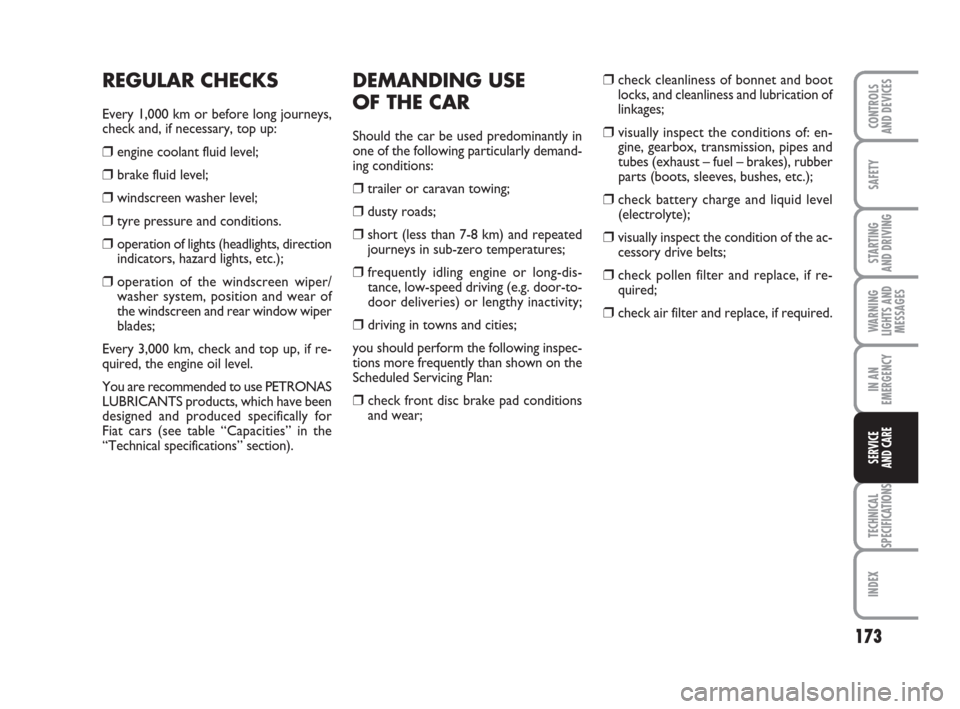
173
SAFETY
STARTING
AND DRIVING
WARNING
LIGHTS AND
MESSAGES
IN AN
EMERGENCY
TECHNICAL
SPECIFICATIONS
INDEX
CONTROLS
AND DEVICES
SERVICE
AND CARE
DEMANDING USE
OF THE CAR
Should the car be used predominantly in
one of the following particularly demand-
ing conditions:
❒trailer or caravan towing;
❒dusty roads;
❒short (less than 7-8 km) and repeated
journeys in sub-zero temperatures;
❒ frequently idling engine or long-dis-
tance, low-speed driving (e.g. door-to-
door deliveries) or lengthy inactivity;
❒ driving in towns and cities;
you should perform the following inspec-
tions more frequently than shown on the
Scheduled Servicing Plan:
❒ check front disc brake pad conditions
and wear;
❒check cleanliness of bonnet and boot
locks, and cleanliness and lubrication of
linkages;
❒ visually inspect the conditions of: en-
gine, gearbox, transmission, pipes and
tubes (exhaust – fuel – brakes), rubber
parts (boots, sleeves, bushes, etc.);
❒check battery charge and liquid level
(electrolyte);
❒visually inspect the condition of the ac-
cessory drive belts;
❒check pollen filter and replace, if re-
quired;
❒check air filter and replace, if required.
REGULAR CHECKS
Every 1,000 km or before long journeys,
check and, if necessary, top up:
❒engine coolant fluid level;
❒brake fluid level;
❒windscreen washer level;
❒tyre pressure and conditions.
❒operation of lights (headlights, direction
indicators, hazard lights, etc.);
❒operation of the windscreen wiper/
washer system, position and wear of
the windscreen and rear window wiper
blades;
Every 3,000 km, check and top up, if re-
quired, the engine oil level.
You are recommended to use PETRONAS
LUBRICANTS products, which have been
designed and produced specifically for
Fiat cars (see table “Capacities” in the
“Technical specifications” section).
167-186 ACTUAL 1ed EN 27-07-2010 10:30 Pagina 173
Page 175 of 216
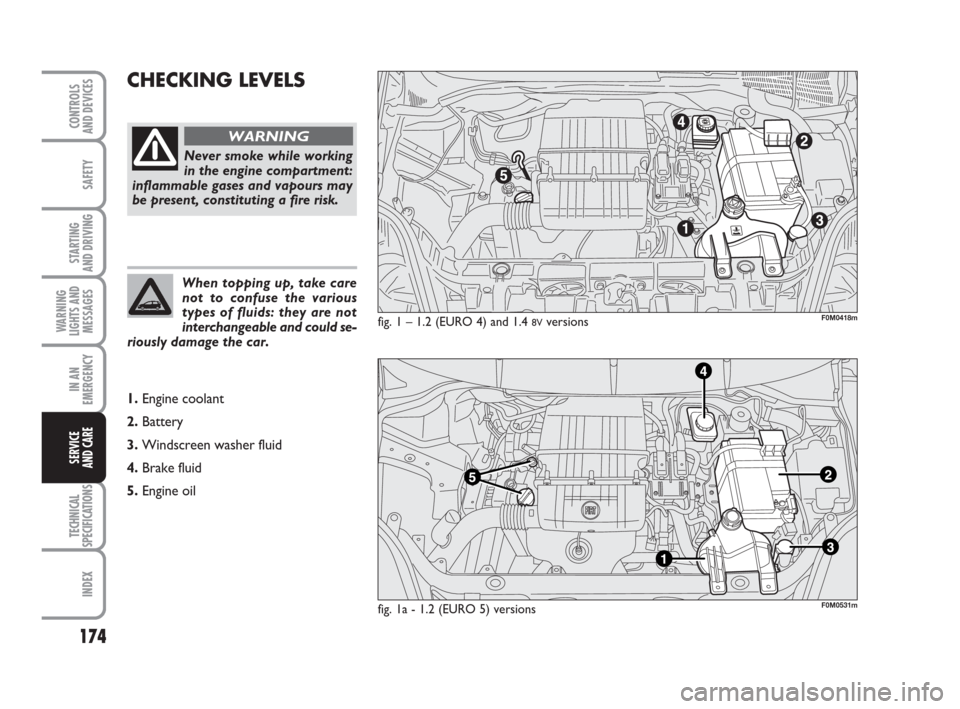
174
SAFETY
STARTING
AND DRIVING
WARNING
LIGHTS AND
MESSAGES
IN AN
EMERGENCY
TECHNICAL
SPECIFICATIONS
INDEX
CONTROLS
AND DEVICES
SERVICE
AND CARE
CHECKING LEVELS
fig. 1 – 1.2 (EURO 4) and 1.4 8Vversions
Never smoke while working
in the engine compartment:
inflammable gases and vapours may
be present, constituting a fire risk.
WARNING
When topping up, take care
not to confuse the various
types of fluids: they are not
interchangeable and could se-
riously damage the car.
1. Engine coolant
2. Battery
3. Windscreen washer fluid
4. Brake fluid
5. Engine oil
F0M0418m
fig. 1a - 1.2 (EURO 5) versionsF0M0531m
167-186 ACTUAL 1ed EN 27-07-2010 10:30 Pagina 174
Page 176 of 216
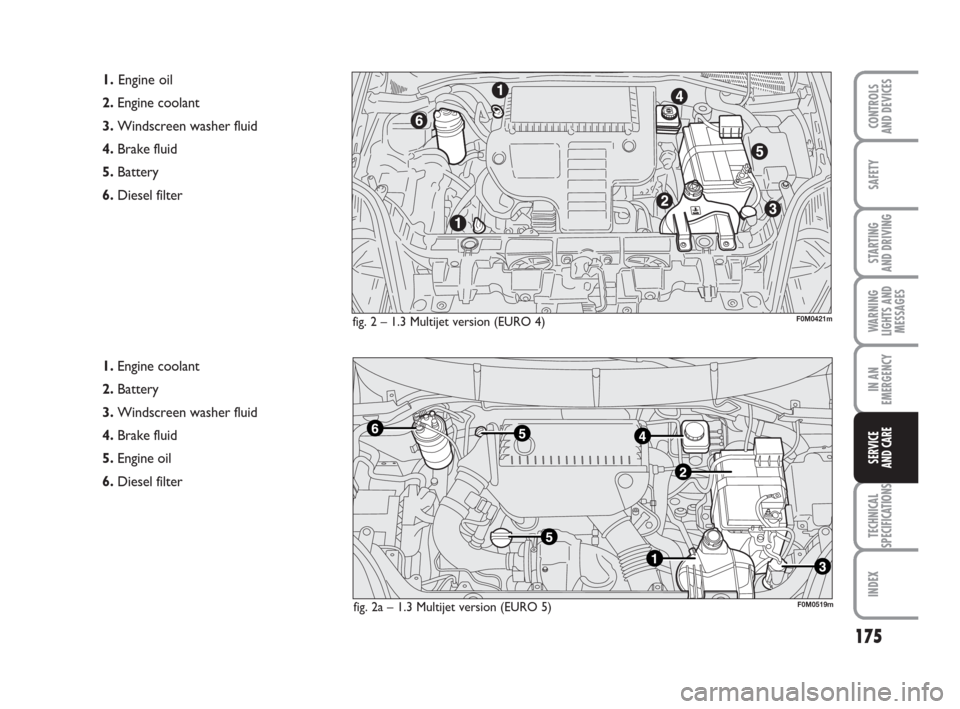
175
SAFETY
STARTING
AND DRIVING
WARNING
LIGHTS AND
MESSAGES
IN AN
EMERGENCY
TECHNICAL
SPECIFICATIONS
INDEX
CONTROLS
AND DEVICES
SERVICE
AND CARE
fig. 2 – 1.3 Multijet version (EURO 4)
1.Engine oil
2. Engine coolant
3. Windscreen washer fluid
4. Brake fluid
5. Battery
6. Diesel filter
1. Engine coolant
2. Battery
3. Windscreen washer fluid
4. Brake fluid
5. Engine oil
6. Diesel filter
F0M0421m
fig. 2a – 1.3 Multijet version (EURO 5)F0M0519m
167-186 ACTUAL 1ed EN 27-07-2010 10:30 Pagina 175
Page 179 of 216
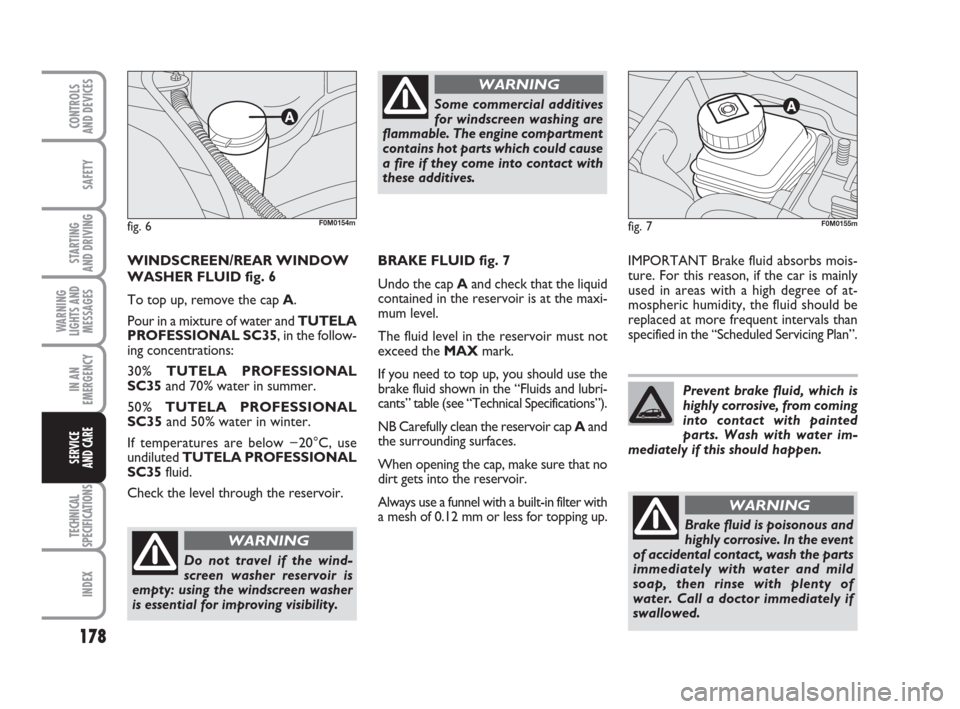
178
SAFETY
STARTING
AND DRIVING
WARNING
LIGHTS AND
MESSAGES
IN AN
EMERGENCY
TECHNICAL
SPECIFICATIONS
INDEX
CONTROLS
AND DEVICES
SERVICE
AND CARE
IMPORTANT Brake fluid absorbs mois-
ture. For this reason, if the car is mainly
used in areas with a high degree of at-
mospheric humidity, the fluid should be
replaced at more frequent intervals than
specified in the “Scheduled Servicing Plan”.
fig. 7
Do not travel if the wind-
screen washer reservoir is
empty: using the windscreen washer
is essential for improving visibility.
WARNING
Some commercial additives
for windscreen washing are
flammable. The engine compartment
contains hot parts which could cause
a fire if they come into contact with
these additives.
WARNING
Prevent brake fluid, which is
highly corrosive, from coming
into contact with painted
parts. Wash with water im-
mediately if this should happen.
WINDSCREEN/REAR WINDOW
WASHER FLUID fig. 6
To top up, remove the cap A.
Pour in a mixture of water and TUTELA
PROFESSIONAL SC35, in the follow-
ing concentrations:
30% TUTELA PROFESSIONAL
SC35and 70% water in summer.
50% TUTELA PROFESSIONAL
SC35and 50% water in winter.
If temperatures are below −20°C, use
undiluted TUTELA PROFESSIONAL
SC35fluid.
Check the level through the reservoir.
fig. 6F0M0154m
BRAKE FLUID fig. 7
Undo the cap Aand check that the liquid
contained in the reservoir is at the maxi-
mum level.
The fluid level in the reservoir must not
exceed the MAXmark.
If you need to top up, you should use the
brake fluid shown in the “Fluids and lubri-
cants” table (see “Technical Specifications”).
NB Carefully clean the reservoir cap Aand
the surrounding surfaces.
When opening the cap, make sure that no
dirt gets into the reservoir.
Always use a funnel with a built-in filter with
a mesh of 0.12 mm or less for topping up.
F0M0155m
Brake fluid is poisonous and
highly corrosive. In the event
of accidental contact, wash the parts
immediately with water and mild
soap, then rinse with plenty of
water. Call a doctor immediately if
swallowed.
WARNING
167-186 ACTUAL 1ed EN 27-07-2010 10:30 Pagina 178
Page 180 of 216

179
SAFETY
STARTING
AND DRIVING
WARNING
LIGHTS AND
MESSAGES
IN AN
EMERGENCY
TECHNICAL
SPECIFICATIONS
INDEX
CONTROLS
AND DEVICES
SERVICE
AND CARE
AIR FILTER
Have the air filter replaced by a Fiat Deal-
ership.
POLLEN FILTER
Have the pollen filter replaced by a Fiat
Dealership.
Symbol πon the container
indicates a synthetic brake
fluid, which is different from a min-
eral fluid. Using a mineral-type fluid
will damage the special rubber seals
of the braking system beyond repair.
WARNINGBATTERY
The battery is of the “Limited mainte-
nance” type: under normal conditions of
use, the electrolyte does not need topping
up with distilled water.
The battery fluid is poiso-
nous and corrosive. Avoid
contact with the skin and eyes. Keep
naked flames or possible sources of
sparks away from the battery: risk of
explosion or fire.
WARNING
CHECKING THE CHARGE
AND THE ELECTROLYTE LEVEL
Inspection operations must be carried out
only by specialised personnel, following
the prescriptions contained in this Own-
er Handbook. Any top-up operations
must be carried out only by specialised
personnel at a Fiat Dealership.
Using the battery when the
fluid is too low can damage
it irreparably and generate a risk of
explosion.
WARNING
REPLACING THE BATTERY
If required, replace the battery with an
original spare part with the same specifi-
cations.
If a battery with different specifications is
fitted, the service intervals given in the
“Scheduled Servicing Plan” will no longer
be valid.
For battery maintenance, you should
therefore refer to the instructions pro-
vided by the battery manufacturer.
167-186 ACTUAL 1ed EN 27-07-2010 10:30 Pagina 179
Page 183 of 216
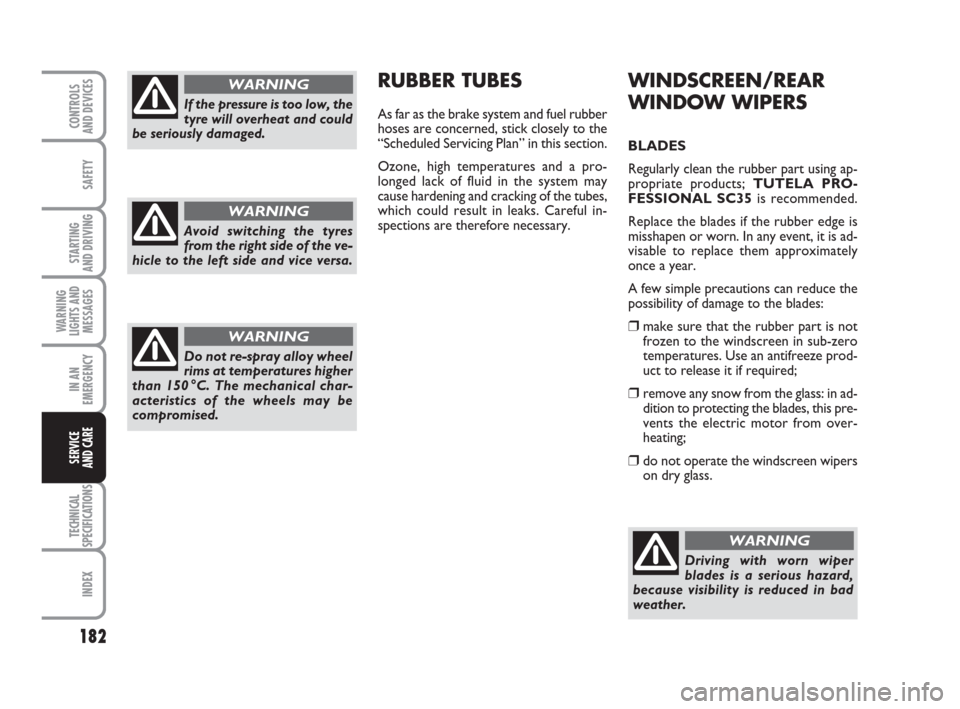
182
SAFETY
STARTING
AND DRIVING
WARNING
LIGHTS AND
MESSAGES
IN AN
EMERGENCY
TECHNICAL
SPECIFICATIONS
INDEX
CONTROLS
AND DEVICES
SERVICE
AND CARE
WINDSCREEN/REAR
WINDOW WIPERS
BLADES
Regularly clean the rubber part using ap-
propriate products; TUTELA PRO-
FESSIONAL SC35is recommended.
Replace the blades if the rubber edge is
misshapen or worn. In any event, it is ad-
visable to replace them approximately
once a year.
A few simple precautions can reduce the
possibility of damage to the blades:
❒make sure that the rubber part is not
frozen to the windscreen in sub-zero
temperatures. Use an antifreeze prod-
uct to release it if required;
❒remove any snow from the glass: in ad-
dition to protecting the blades, this pre-
vents the electric motor from over-
heating;
❒do not operate the windscreen wipers
on dry glass.
Driving with worn wiper
blades is a serious hazard,
because visibility is reduced in bad
weather.
WARNING
RUBBER TUBES
As far as the brake system and fuel rubber
hoses are concerned, stick closely to the
“Scheduled Servicing Plan” in this section.
Ozone, high temperatures and a pro-
longed lack of fluid in the system may
cause hardening and cracking of the tubes,
which could result in leaks. Careful in-
spections are therefore necessary.If the pressure is too low, the
tyre will overheat and could
be seriously damaged.
WARNING
Avoid switching the tyres
from the right side of the ve-
hicle to the left side and vice versa.
WARNING
Do not re-spray alloy wheel
rims at temperatures higher
than 150 °C. The mechanical char-
acteristics of the wheels may be
compromised.
WARNING
167-186 ACTUAL 1ed EN 27-07-2010 10:30 Pagina 182
Page 188 of 216

187
SAFETY
STARTING
AND DRIVING
WARNING
LIGHTS AND
MESSAGES
IN AN
EMERGENCY
SERVICE
AND CARE
INDEX
CONTROLS
AND DEVICES
TECHNICAL
SPECIFICATIONS
IDENTIFICATION DATA ................................................. 188
ENGINE CODES – BODYWORK VERSIONS ............. 184
ENGINE .................................................................................. 191
FUEL SUPPLY ........................................................................ 192
TRANSMISSION .................................................................. 192
BRAKES .................................................................................. 193
SUSPENSIONS ...................................................................... 193
STEERING SYSTEM ............................................................. 193
WHEELS ................................................................................. 194
PERFORMANCES ................................................................ 197
DIMENSIONS ....................................................................... 198
WEIGHTS .............................................................................. 199
CAPACITIES .......................................................................... 201
FLUIDS AND LUBRICANTS ............................................. 202
FUEL CONSUMPTION ...................................................... 204
CO
2EMISSIONS .................................................................. 204
T T
E E
C C
H H
N N
I I
C C
A A
L L
S S
P P
E E
C C
I I
F F
I I
C C
A A
T T
I I
O O
N N
S S
187-204 ACTUAL 1ed EN 26-07-2010 16:08 Pagina 187
Page 200 of 216
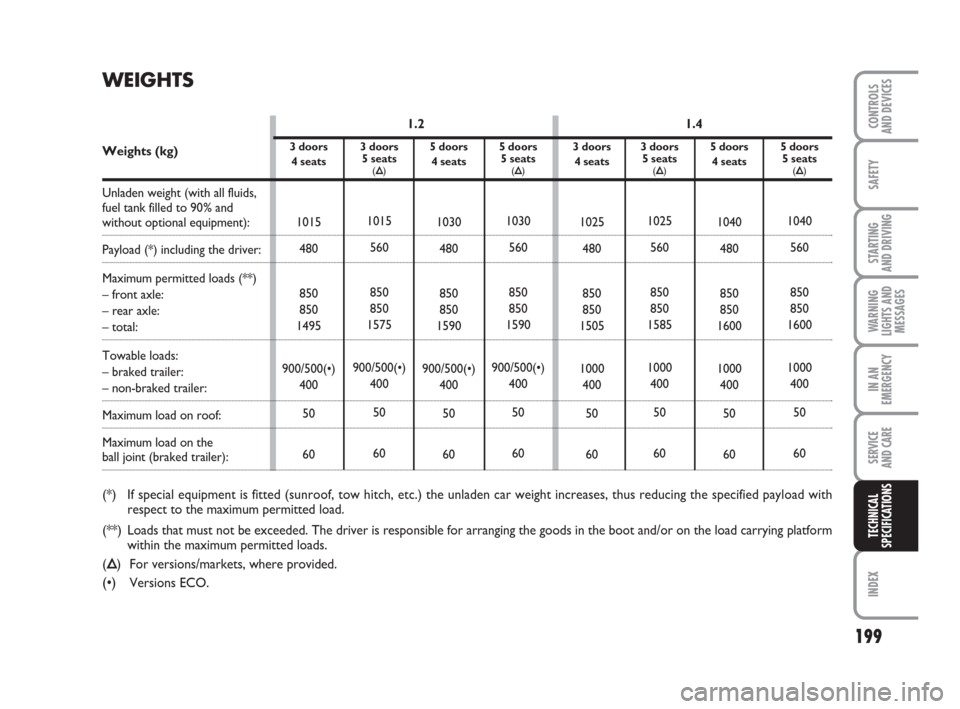
5 doors
4 seats
1030
480
850
850
1590
900/500(•)
400
50
60
5 doors
5 seats
(Õ)
1030
560
850
850
1590
900/500(•)
400
50
60
3 doors
4 seats
1025
480
850
850
1505
1000
400
50
60
3 doors
5 seats
(Õ)
1025
560
850
850
1585
1000
400
50
60
5 doors
4 seats
1040
480
850
850
1600
1000
400
50
60
5 doors
5 seats
(Õ)
1040
560
850
850
1600
1000
400
50
60
3 doors
4 seats
1015
480
850
850
1495
900/500(•)
400
50
60
3 doors
5 seats
(Õ)
1015
560
850
850
1575
900/500(•)
400
50
60
199
SAFETY
STARTING
AND DRIVING
WARNING
LIGHTS AND
MESSAGES
IN AN
EMERGENCY
SERVICE
AND CARE
INDEX
CONTROLS
AND DEVICES
TECHNICAL
SPECIFICATIONS
WEIGHTS
1.2 1.4
Weights (kg)
Unladen weight (with all fluids,
fuel tank filled to 90% and
without optional equipment):
Payload (*) including the driver:
Maximum permitted loads (**)
– front axle:
– rear axle:
– total:
Towable loads:
– braked trailer:
– non-braked trailer:
Maximum load on roof:
Maximum load on the
ball joint (braked trailer):
(*) If special equipment is fitted (sunroof, tow hitch, etc.) the unladen car weight increases, thus reducing the specified payload with
respect to the maximum permitted load.
(**) Loads that must not be exceeded. The driver is responsible for arranging the goods in the boot and/or on the load carrying platform
within the maximum permitted loads.
(Õ) For versions/markets, where provided.
(•)Versions ECO.
187-204 ACTUAL 1ed EN 26-07-2010 16:08 Pagina 199